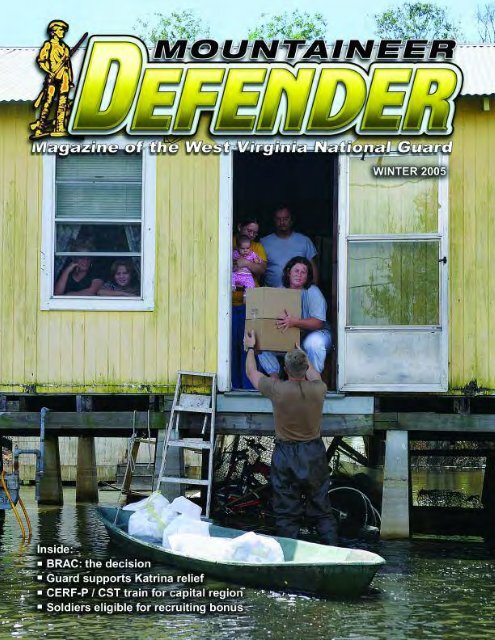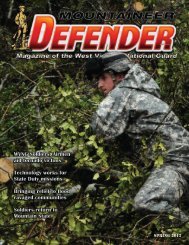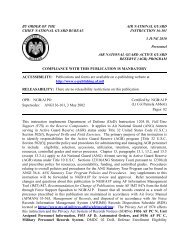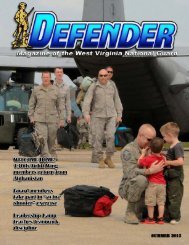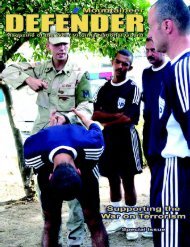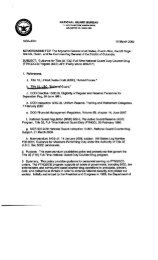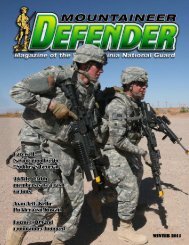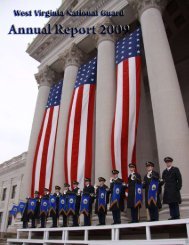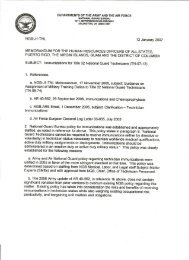2005 Q2 - West Virginia Army National Guard - U.S. Army
2005 Q2 - West Virginia Army National Guard - U.S. Army
2005 Q2 - West Virginia Army National Guard - U.S. Army
You also want an ePaper? Increase the reach of your titles
YUMPU automatically turns print PDFs into web optimized ePapers that Google loves.
Magazine of the<br />
<strong>West</strong> <strong>Virginia</strong> <strong>National</strong> <strong>Guard</strong><br />
Winter <strong>2005</strong><br />
In this issue:<br />
• Command Messages 3<br />
• Cover story: 4<br />
WV <strong>Guard</strong> contributes<br />
to Katrina relief effort<br />
• BRAC Commission saves 7<br />
state Air <strong>Guard</strong> base<br />
• Photos from Katrina 8<br />
• CERFP & CST train 10<br />
for capital region response<br />
• Counterdrug soldiers 11<br />
bring joy to hospital kids<br />
• Ex-commander leads 12<br />
community to BRAC victory<br />
• DoD announces 13<br />
awards for Katrina<br />
• Close Combat Badge 13<br />
announced for soldiers<br />
• <strong>Guard</strong> soldier 14<br />
first to earn new<br />
recruiting bonus<br />
• News you can use 15<br />
Page<br />
7<br />
Page<br />
12<br />
Page<br />
10<br />
Page<br />
14<br />
On the cover:<br />
Capt. James Fletcher, 2d Bn, 19th<br />
SFG(A) delivers food and water to<br />
flood victims in Houma, Louisiana.<br />
Read more about <strong>West</strong> <strong>Virginia</strong><br />
<strong>National</strong> <strong>Guard</strong>’s response to<br />
Hurricanes Katrina and Rita on<br />
Page 4<br />
Adjutant General<br />
Maj. Gen. Allen E. Tackett<br />
State Command Sergeant Major<br />
Command Sgt. Maj.<br />
Lawrence R. Vance<br />
State Command<br />
Chief Master Sergeant<br />
Command Chief Master Sgt.<br />
Ronald D. Bowe II<br />
State Public Affairs Officer<br />
& Editor-in-Chief<br />
Lt. Col. Mike Cadle<br />
Design & Layout<br />
Maj. Todd Harrell<br />
The Mountaineer Defender is an<br />
authorized publication of the<br />
<strong>West</strong> <strong>Virginia</strong> <strong>National</strong> <strong>Guard</strong>.<br />
Contents are not necessarily the<br />
official views of, nor are they<br />
endorsed by, the U.S. government,<br />
the Department of<br />
Defense, the <strong>West</strong> <strong>Virginia</strong><br />
<strong>National</strong> <strong>Guard</strong> or the state of<br />
<strong>West</strong> <strong>Virginia</strong>. Publication of<br />
material is determined by available<br />
space and reader interest.<br />
The staff reserves the right to edit<br />
all material.<br />
Send comments/contributions to:<br />
State Public Affairs Office<br />
WV <strong>National</strong> <strong>Guard</strong><br />
1679 Coonskin Drive<br />
Charleston, WV 25311<br />
or<br />
defender@wvchar.ang.af.mil<br />
Photo by:<br />
Maj. Todd Harrell, 153d MPAD<br />
2<br />
M O U N T A I N E E R<br />
DEFENDER
The Adjutant General<br />
Our soldiers and airmen really proved<br />
their worth in <strong>2005</strong>. We completed<br />
another round of deployments. New<br />
facilities dot the <strong>West</strong> <strong>Virginia</strong> landscape.<br />
We met end strength goals and<br />
finished the year over 100 percent for<br />
the eighth consecutive year.<br />
One of the most important things we<br />
did was support Gulf Coast hurricane<br />
recovery operations. I am so proud of<br />
the 1,000-plus soldiers and airmen who<br />
took part in operations at the Charleston<br />
air base, Camp Dawson, Belle Chasse<br />
operations center, Terrebonne Parish,<br />
and so many other places that our members<br />
helped those in desperate need.<br />
But <strong>2005</strong> also brought great challenges,<br />
including the greatest single<br />
threat to our <strong>National</strong> <strong>Guard</strong> that we’ve<br />
faced in many years -- BRAC. Closing<br />
the Charleston air base would have had<br />
a devastating effect on our strength and<br />
Maj. Gen. Allen E. Tackett<br />
readiness. The effort to save the base<br />
was massive, and I thank all of you for<br />
getting involved.<br />
Budget and troop concerns are also<br />
pressing issues. DOD is in the midst of<br />
another Quadrennial Defense Review,<br />
and the Air Force is trying to determine<br />
its future force structure. Changes in<br />
funding and manpower allocations could<br />
affect every aspect of our operations.<br />
What does the future hold It’s likely<br />
that it will hold much of the same --<br />
more deployments, continued uncertainty<br />
regarding future funding and force<br />
structure, and hard work. But we’ll<br />
overcome these challenges if everyone<br />
remembers the things that make us successful<br />
– maintaining strength and readiness,<br />
taking care of soldiers and families,<br />
looking for opportunities to grow<br />
the WVNG. Embrace these goals, and<br />
our organization will continue to be recognized<br />
as one of the best in the nation.<br />
I wish each of you the best in the<br />
coming year!<br />
State Command Chief Master Sergeant<br />
I am extremely grateful to be your<br />
State Command Chief Master Sergeant.<br />
I thank the leadership of this state for<br />
allowing me this opportunity. The<br />
shoes that I have to fill due to retirement<br />
of Chief Master Sgt. Dan Chandler will<br />
be a challenge to say the least, but I am<br />
up to the task. We’ve faced some challenges<br />
in the recent past, such as the<br />
BRAC Commission fight at the 130th in<br />
which the state pulled together to save<br />
Command Chief Master Sgt. Bowe<br />
the unit. Another challenge that lies<br />
ahead is that of the C-5 conversion at the 167th. We will work<br />
together to ensure this transition is as smooth as possible.<br />
MY VISION is an enlisted force capable of going anywhere at<br />
any time to accomplish any mission. I’ll work for a well-organized<br />
and equipped enlisted force that is all-inclusive, where<br />
everyone has a sense of purpose and is a valued member of our<br />
state organizations.<br />
I SEE THE JOB as taking care of the enlisted force by working<br />
through both Wing command chiefs. Our goal will be to assess<br />
the morale and welfare of both units by attending unit functions,<br />
such as enlisted council meetings and functional area units, and<br />
will include assessing feedback from the enlisted force and<br />
Commanders.<br />
MY ROLE is to establish a closer rapport with commanders,<br />
senior officers, chiefs, senior enlisted, family readiness, and<br />
employer support of <strong>Guard</strong> and Reserves. I will establish effective<br />
communications by unit visits, attending Commanders Calls,<br />
joining deployments, and being involved in unit retirements, promotions<br />
and award ceremonies.<br />
MY PLACE IN THE ORGANIZATION is as the senior enlisted<br />
grade in the state. I will be a mouthpiece for both the enlisted<br />
personnel and senior leadership.<br />
State Command Sergeant Major<br />
As we enjoy the Christmas and<br />
New Year season with our friends and<br />
family, let us not forget those deployed<br />
Soldiers and Airmen of the <strong>West</strong><br />
<strong>Virginia</strong> <strong>National</strong> <strong>Guard</strong>. Our soldiers<br />
miss out on many special family<br />
events such as weddings, graduations<br />
and other milestones. The cost of being<br />
a patriot comes at a high price. Some<br />
have given their all. In recent years our<br />
fellow guardsmen, with their families,<br />
Command Sgt. Maj. Vance<br />
have answered the call of our nation.<br />
<strong>West</strong> <strong>Virginia</strong> Soldiers and Airmen have served in many places<br />
around the world enduring many hardships.<br />
These outstanding Citizen Soldiers have also served in hurricane<br />
recovery operations. “Neighbors helping neighbors,” the<br />
adopted slogan, describes the mission best. The senior leadership<br />
of the state and nation have noted many outstanding accomplishments<br />
during these operations.<br />
Our soldiers have kept a pace like no other in the 369 years of<br />
the <strong>National</strong> <strong>Guard</strong>’s existence. The patriotism of our guardsmen<br />
is second to none. Different people have asked me if it is really<br />
worth it all. As I travel from unit to unit taking part in celebrations<br />
of Christmas and other very important events, I see smiling<br />
children, wives and husbands enjoying each other’s company<br />
and the freedom that our Citizen Soldiers value and guard so<br />
fervently. I say to everyone it is worth it all! This is the birthright<br />
and the legacy of a guardsman. So this Christmas and New<br />
Year’s season is extra special to many of our fellow guardsman<br />
who have returned from recent deployments. We don’t know<br />
what trials our nation will face in the New Year. However, our<br />
nation’s citizens can be assured that the <strong>West</strong> <strong>Virginia</strong> <strong>Guard</strong><br />
will be ready and willing to tackle any mission given.<br />
WINTER <strong>2005</strong><br />
3
By Maj. Todd Harrell<br />
153d Mobile Public Affairs Detachment<br />
In August, <strong>2005</strong>, nature dealt the Gulf<br />
Coast a devastating blow that would test<br />
our nation and potentially redefine the role<br />
of the <strong>National</strong> <strong>Guard</strong>. When hurricanes<br />
Katrina and Rita struck, <strong>Guard</strong> personnel<br />
from all 54 states and territories responded<br />
in the largest domestic <strong>National</strong> <strong>Guard</strong><br />
mobilization in U.S. history.<br />
<strong>West</strong> <strong>Virginia</strong>’s response to Hurricane<br />
Katrina began more than a week before<br />
the storm made landfall. The <strong>Guard</strong>’s<br />
Emergency Operations Center in<br />
Charleston was manned around the clock,<br />
monitoring the storm’s progress and<br />
identifying assets and resources. Leaders<br />
began developing plans should the storm<br />
drive north and threaten <strong>West</strong> <strong>Virginia</strong>.<br />
Next, the staff developed a response plan<br />
to support the gulf region.<br />
<strong>National</strong> <strong>Guard</strong> Bureau was well aware<br />
of <strong>West</strong> <strong>Virginia</strong>’s experience in flood<br />
operations. “When the magnitude of the<br />
devastation became evident, we received a<br />
call from the joint staff at NGB requesting<br />
our assistance,” recalls Col. Johnnie L.<br />
Young, deputy commander, land component,<br />
<strong>West</strong> <strong>Virginia</strong> <strong>National</strong> <strong>Guard</strong>.<br />
The response<br />
<strong>West</strong> <strong>Virginia</strong>’s first response was to<br />
launch C-130’s from the 130th and 167th<br />
Airlift Wings to assist in the evacuation.<br />
Maj. Kevin Meagher of the 130th Airlift<br />
Wing piloted the first C-130 from <strong>West</strong><br />
<strong>Virginia</strong> into New Orleans’ Airport.<br />
Photo by Capt. Paula Sydenstricker, Det.1 196th MPAD<br />
In the shadow of the Louisiana Superdome, a<br />
<strong>West</strong> <strong>Virginia</strong> <strong>National</strong> <strong>Guard</strong> convoy enters<br />
flooded downtown New Orleans.<br />
“We didn’t know what to expect,” tells<br />
Meagher. “There was a lot of disjointed<br />
information both in the air and on the<br />
ground.” This flight was also significant<br />
because it delivered battery powered lights<br />
Photo by Maj. Todd Harrell, 153d MPAD<br />
allowing the airport to conduct twenty-four<br />
hour operations. Even a C-17 grounded<br />
by nightfall was now able to continue its<br />
lifesaving mission. In addition to delivering<br />
critical lighting equipment, the plane also<br />
brought in an Air medical crew from Pope<br />
Air Force Base to establish an initial triage<br />
at the airport. The aircraft was reconfigured<br />
and loaded with medical evacuees who were<br />
transported to San Antonio for treatment.<br />
Additional <strong>West</strong> <strong>Virginia</strong> aircraft would<br />
soon follow suit bringing in more forces<br />
and supplies and evacuating the victims.<br />
Brig. Gen. John E. Barnette, <strong>West</strong><br />
<strong>Virginia</strong>’s assistant adjutant general for<br />
<strong>Army</strong> and land component commander,<br />
was returning home from Korea when he<br />
received a call from Adjutant General<br />
Allen E. Tackett asking him to lead a<br />
<strong>West</strong> <strong>Virginia</strong> task force into Louisiana.<br />
The first <strong>West</strong> <strong>Virginia</strong> ground forces<br />
arrived at Belle Chasse Naval Air Station<br />
on Sept 3. Minutes from downtown New<br />
Orleans, the small reserve airfield soon<br />
became a critical hub in the relief effort<br />
and the staging area for Task Force<br />
<strong>West</strong> <strong>Virginia</strong>.<br />
4<br />
M O U N T A I N E E R<br />
DEFENDER
Photo by Maj. Todd Harrell, 153d MPAD<br />
Left: Members of Task Force <strong>West</strong> <strong>Virginia</strong> work with Louisiana <strong>National</strong> <strong>Guard</strong> in the Joint<br />
Operations Center, Belle Chasse, La. Left Inset: Victims of Hurricane Katrina prepare to board<br />
a C-130 from Charleston’s 130th Airlift Wing. Above: Staff Sgt. Jeffrey Edmunds and Sgt. John G.<br />
Arnold deliver drinking water and food to flood victims in Houma, La.<br />
Photo by Maj. Todd Harrell, 153d MPAD<br />
The arrival<br />
Barnette was on the flight deck as the<br />
C-130 approached New Orleans. He brought<br />
additional staff members forward for their<br />
first look at the flooding. “At first there<br />
was no point of reference. Everything was<br />
still under water,” said Barnette. “It probably<br />
took us 48 hours on the ground to even<br />
begin to comprehend the level of<br />
devastation. It was much deeper than the<br />
media had represented.” The first aircraft<br />
arrived carrying security and staff personnel<br />
with enough food, water and equipment to<br />
sustain themselves for 15 days. A ground<br />
convoy arrived in Belle Chasse later that<br />
day with 62 vehicles and 120 personnel.<br />
Staff Sgt. Richard A. Rose, a mechanic<br />
with A Co., 1092d Engineer Battalion,<br />
was in that convoy. “With the armor, the<br />
weapons…it was similar to rolling into<br />
Baghdad,” recounts Rose. Another A Co.<br />
member, Spc. Shane Dillon, recalls their<br />
arrival in New Orleans. “There was so<br />
much confusion. We had to find a place to<br />
start. That was the hardest part,” said<br />
Dillon. “You think you’re prepared coming<br />
down here, then you see the devastation.<br />
You feel lost.” Dillon, like others did manage<br />
to find his role. Dillon’s commander,<br />
Capt. Brent A. Schultz, noted,<br />
“We had to tell Dillon to slow down. He<br />
would finish his shift but remain in the<br />
shelter, sometimes twenty hours a day.”<br />
Dillon and his peers were taken in by the<br />
children. “They just saw us as G.I. Joes<br />
and wanted to climb on us,” remembers<br />
Dillon. “You cannot ‘not’ get involved<br />
with these kids.” Capt. Schultz’s team<br />
brought more to the shelter than flood<br />
supplies. They brought along friendship<br />
and delivered compassion. According to<br />
Schultz, “ We got to know them. For the<br />
first time [since the flood], they felt like<br />
someone actually cared about them.”<br />
Photo by Capt. Paula Sydenstricker, Det.1 196th MPAD<br />
Task Force <strong>West</strong> <strong>Virginia</strong> works closely with<br />
Oregon <strong>Guard</strong>smen during search and recovery<br />
operations following Hurricane Katrina.<br />
Developing the mission<br />
Lt. Col. Donald G. Lockard, commander,<br />
151st MP Battalion, led the first <strong>West</strong><br />
<strong>Virginia</strong> security forces into Louisiana.<br />
According to Lockard, “The challenge was<br />
that the mission was developing, the<br />
response was developing – everything was<br />
developing. It was purple…truly a joint<br />
operation with <strong>Army</strong>, Marine, Navy, Air<br />
Force and Coast <strong>Guard</strong> working together,”<br />
said Lockard. “You had a large influx of<br />
people. Everyone trying to help - we needed<br />
to synchronize their efforts.” Working<br />
closely with the J2 staff, Barnette’s first<br />
goal was a comprehensive assessment.<br />
“There was scattered knowledge, so our<br />
staff developed the first intel estimate,<br />
which was used by everyone,” noted<br />
Barnette.<br />
<strong>West</strong> <strong>Virginia</strong> Delivers<br />
With much of New Orleans still submerged,<br />
Task Force <strong>West</strong> <strong>Virginia</strong> now<br />
had a defined mission. Initially, the task<br />
force had expected to support a single<br />
parish, similar to a county in other states.<br />
Realizing the scope of the operation, members<br />
modified their plan to accommodate<br />
11 parishes. Now anticipating a <strong>Guard</strong><br />
strength approaching 40,000, the task force<br />
focused on establishing a Reception<br />
Staging and Onward Integration (RSOI)<br />
operation at Belle Chasse. “It was the<br />
vision of our leadership,” according to one<br />
staff officer. “General Barnette stayed three<br />
steps ahead of everyone else in the operation.<br />
He forced us to think. He challenged<br />
us.” Barnette worked closely with his<br />
WINTER <strong>2005</strong><br />
5
Coins were minted to reflect<br />
<strong>West</strong> <strong>Virginia</strong>’s participation<br />
in the hurricane relief effort.<br />
Louisiana counterpart, Brig. Gen. Hunt<br />
Downer. But Barnette was clear from the<br />
beginning, “We’re not here to take over<br />
the operation. It’s Louisiana’s show.<br />
Eighty percent of their forces have been<br />
personally impacted by Katrina. We’re<br />
here to assist until they can get<br />
back on their feet.”<br />
As the RSOI mission grew, so<br />
did the logistical requirements to<br />
support the troops. At one point,<br />
Belle Chasse was home to nearly<br />
25,000 service members.<br />
Responsibility for logistics fell<br />
upon Col. Larry A. Brown, <strong>West</strong><br />
<strong>Virginia</strong>’s J4. His first task was to<br />
establish the Logistics Support<br />
Area (LSA) for Belle Chasse. The<br />
role of the LSA soon grew, to support<br />
all 11 affected parishes.<br />
Brown and his fledgling staff<br />
proved equal to the task. “I took a<br />
lot of junior personnel down there.<br />
We’d drop them in and they’d take<br />
off and run with the mission with little or<br />
no supervision,” said Brown. “It really<br />
opened my eyes to witness the caliber of<br />
junior leaders and NCO’s we have in the<br />
organization.” Brown went on to point out<br />
how well the staff integrated with other<br />
state’s personnel and representatives from<br />
<strong>National</strong> <strong>Guard</strong> Bureau. Overwhelmed,<br />
yet under control, <strong>West</strong> <strong>Virginia</strong>’s role<br />
would only increase.<br />
6 M O U N T A I N E E R<br />
DEFENDER<br />
Photo by Maj. Todd Harrell, 153d MPAD<br />
Spc. Ricky Paugh of the 1092d<br />
Eng. Bn. looks for flood victims in<br />
need of food, water and cleaning<br />
supplies during relief operations<br />
in Houma, La.<br />
Ready for Rita<br />
Less than a month after Katrina,<br />
Hurricane Rita was heading north towards<br />
the Louisiana coast. With Katrina labeled<br />
“a one hundred year storm,” no one could<br />
have imagined another hurricane so soon.<br />
Photo by Maj. Todd Harrell, 153d MPAD<br />
Along the gulf coast lay reminders of the awesome destructive<br />
power of hurricanes Katrina and Rita. Two ships displaced in<br />
the small fishing town of Empire, La. represent just one of<br />
many unique challenges faced throughout the recovery effort.<br />
“It was like a poorly written CPX (command<br />
post exercise),” remarked Brig.<br />
Gen. Barnette, referring to the constant<br />
challenges presented throughout the operation.<br />
At times, it seemed as if the most<br />
unimaginable scenarios became routine.<br />
Before Rita reached Louisiana, Brown and<br />
his staff built a plan that called for a<br />
Direct Support Brigade (DSB) and three<br />
LSA’s to provide logistical support for the<br />
entire state. “In <strong>West</strong> <strong>Virginia</strong>, we’ve done<br />
floods where we supported 2,500 troops,”<br />
stated Brown. “All I did was take that<br />
process and expand it ten times.” In the<br />
midst of the nation’s most catastrophic<br />
event, his plan worked. And not only did<br />
this plan work, Brown and his staff went on<br />
to accept the FEMA logistics role as well.<br />
The rest of the story<br />
As significant as their role in logistics,<br />
<strong>West</strong> <strong>Virginia</strong> troops were dispatched<br />
throughout the region to support numerous<br />
diverse missions.<br />
In Mississippi, the J6 ISISCS [communications]<br />
van provided communications<br />
throughout regions where telephone and<br />
power systems had failed. The small team<br />
of Air and <strong>Army</strong> <strong>Guard</strong> personnel established<br />
a work model so effective that their<br />
systems will be fielded to every state.<br />
In Gulfport, members of the 167th Air<br />
Wing provided aerial port operations for<br />
aircraft bringing personnel and supplies to<br />
the Mississippi coast.<br />
The depth of <strong>West</strong> <strong>Virginia</strong> involvement<br />
in the relief effort extended far beyond the<br />
scope of this article. The barely mentioned<br />
Emergency Operations center in<br />
Charleston was critical in every aspect of<br />
the operation. Personnel, many rotating to<br />
and from Louisiana, would return<br />
home to supplement EOC staff.<br />
At Camp Dawson, a shelter was<br />
established to house more than 300<br />
hurricane victims. <strong>National</strong> <strong>Guard</strong>,<br />
the Office of Emergency Services,<br />
Department of Health and Human<br />
Resources, State Police and countless<br />
other state organizations<br />
worked together to bring the faces<br />
of Katrina right here to the<br />
mountain state.<br />
In all, nearly 1,200 volunteers<br />
from the mountain state served in<br />
the relief effort. By all accounts,<br />
<strong>West</strong> <strong>Virginia</strong>’s <strong>National</strong> <strong>Guard</strong><br />
proved that even a relatively small<br />
force of experienced, dedicated<br />
troops with strong leadership can overcome<br />
seemingly insurmountable odds,<br />
even under the most austere conditions.<br />
More than three months after hurricanes<br />
Katrina and Rita struck, more than two<br />
dozen <strong>West</strong> <strong>Virginia</strong> service members<br />
remain in Louisiana filling various roles,<br />
and with them remains the Mountaineer<br />
spirit and our legacy of “Neighbors<br />
Helping Neighbors.”
Commission votes to keep C-130s in Charleston<br />
By Lt. Col. Mike Cadle<br />
Joint Forces HQ, Public Affairs Office<br />
A nine member panel convened by<br />
President Bush to evaluate the Defense<br />
Department’s plan to close or realign<br />
more than 800 military installations voted<br />
Aug. 26 to save the Air <strong>Guard</strong> Base at<br />
Yeager Airport.<br />
BRAC analysts presented a report to<br />
commissioners during final deliberations,<br />
harshly criticizing the Air Force and calling<br />
data regarding the realignment of the<br />
130th Airlift Wing “inaccurate and outdated.”<br />
Commissioners later voted 9-0 to<br />
remove the 130th from recommendations<br />
it will send to the President.<br />
Under the Pentagon proposal, eight<br />
C-130 Hercules aircraft and about 600 of<br />
the 130th Airlift Wing’s employees would<br />
have been transferred to Pope Air Force<br />
Base, N.C. Charleston’s Air <strong>Guard</strong> base<br />
would have become an enclave, home<br />
to members whose primary mission<br />
would be training and deployment for<br />
contingency operations.<br />
The mood was festive on Coonskin<br />
Drive as word spread that the base had<br />
been spared. Some troops celebrated<br />
by high-fiving their coworkers, while<br />
others took to the phones to tell family<br />
members that the uncertainty surrounding<br />
the base had finally been resolved.<br />
Base Commander Col. Tim Frye called<br />
a meeting of the unit’s full-time workers<br />
to spread the good news. Adjutant<br />
General Allen Tackett received a standing<br />
ovation from the energized crowd when<br />
he proclaimed, “What a great day for the<br />
130th Airlift Wing!”<br />
Gov. Joe Manchin and Tackett led<br />
elected officials and community leaders<br />
in the fight to save the base.<br />
Manchin wrote to commissioners daily<br />
to express his concerns about losing<br />
specialized homeland security response<br />
capabilities found at the 130th. He<br />
praised the Commission for seeking input<br />
from the states.<br />
“I’m pleased that Chairman Principi<br />
and the BRAC commissioners looked at<br />
the facts closely,” Manchin said. The<br />
130th is an important part of <strong>West</strong><br />
<strong>Virginia</strong>’s ability to respond to natural<br />
disasters or potential terrorist incidents,<br />
and I am very happy with the<br />
Commission’s decision.”<br />
Tackett applauded the efforts of those<br />
who worked hard to save the base. “We’ve<br />
had such an outpouring of support from<br />
our elected officials and local communities,”<br />
he said. “Sen. Byrd mobilized the<br />
congressional delegation, Gov. Manchin<br />
mobilized state government, and Keep<br />
‘em Flying mobilized our communities.”<br />
But Tackett heaped the greatest praise<br />
on airmen at the 130th Airlift Wing.<br />
“Community support doesn’t mean much<br />
if a unit can’t perform its mission,” he<br />
said. “It’s the support 130th members<br />
consistently provide to the state and<br />
nation, particularly since 9/11, that proves<br />
the true military value of the unit.<br />
“This is a great day for the citizens of<br />
<strong>West</strong> <strong>Virginia</strong> and the <strong>West</strong> <strong>Virginia</strong> Air<br />
<strong>National</strong> <strong>Guard</strong>,” Tackett said.<br />
Frye celebrated with unit members, but<br />
worried that this was only the first battle<br />
in a long fight. “I’m very pleased that we<br />
dodged the BRAC bullet this year. “But<br />
DOD is still pushing transformation, and<br />
that means we have to be concerned<br />
about QDR [Quadrennial Defense Review]<br />
and Future Total Force,” he said.<br />
Frye explained that QDR is a process<br />
accomplished every four years in which<br />
Pentagon planners review military<br />
missions and capabilities of all services<br />
and their active and reserve components.<br />
Future Total Force is an attempt to identify<br />
the right force structure to counter emerging<br />
threats facing the U.S. today, he said.<br />
Editor’s note:<br />
President Bush and Congress accepted<br />
the BRAC Commission’s recommendations,<br />
which became law on Nov. 9. DoD has two<br />
years to begin closing and realigning<br />
affected installations.<br />
WINTER <strong>2005</strong><br />
7
Photo by Sgt. 1st Class Chuck Joseph, Det 1,196th MPAD<br />
Spc. Jessica Brandon, 196th MPAD, talks to<br />
Lt. Gen. H. Steven Blum, Chief, <strong>National</strong><br />
<strong>Guard</strong> Bureau, during his visit to Naval Air<br />
Station New Orleans, Belle Chasse, La.<br />
Photo by Capt. Paula Sydenstricker, Det.1 196th MPAD<br />
Vehicles from Task Force <strong>West</strong> Virgina rolled into Belle Chasse Naval Air<br />
Station on Sept. 3, <strong>2005</strong>, to begin relief operations. Belle Chasse would<br />
soon evolve into the logistics hub for the entire relief effort.<br />
Photo by Capt. Paula Sydenstricker, Det.1 196th MPAD<br />
Brig. Gen. John E. Barnette discusses Direct Support<br />
Brigade operations with Louisiana Assistant Adjutant<br />
General Hunt Downer at Belle Chasse Naval Air Station.<br />
Photo by Capt. Paula Sydenstricker, Det.1 196th MPAD<br />
Col. William E. Aldridge, chief of staff for Task Force <strong>West</strong> <strong>Virginia</strong>,<br />
confers with Louisiana <strong>National</strong> <strong>Guard</strong> Deputy Chief of Staff Col. Glen<br />
Curtis on Sept. 4 outside the Superdome in New Orleans. The <strong>West</strong><br />
<strong>Virginia</strong> contingent was preparing to augment the Louisiana troops<br />
who had been working non-stop since Hurricane Katrina hit.<br />
Photo by Master Sgt. Sean M. Brennan, 167th Airlift Wing<br />
Tech. Sgt. Michael Bowman and Senior Airman Ryan M.<br />
Caponi of the 167th Airlift Wing land at Belle Chasse Naval<br />
Air Station to assist in flood relief efforts.<br />
8 M O U N T A I N E E R<br />
DEFENDER
Photo by Capt. Paula Sydenstricker, Det.1 196th MPAD<br />
Capt. Brent Schultz briefs Spc. Curtis Cook and other soldiers during<br />
relief operations in the wake of Hurricane Katrina.<br />
Photo by Capt. Paula Sydenstricker, Det.1 196th MPAD<br />
Television personality Oprah Winfrey meets with <strong>Guard</strong> members outside the Louisiana<br />
Superdome as flood waters recede from New Orleans.<br />
Photo by Maj. Todd Harrell, 153d MPAD<br />
Brig. Gen. John E. Barnette speaks with a reporter from FOX news about<br />
the <strong>National</strong> <strong>Guard</strong>’s mission during a visit to Houma, La.<br />
Photo by Capt. Paula Sydenstricker, Det.1 196th MPAD<br />
Members of Task Force <strong>West</strong> <strong>Virginia</strong> rest in place at Belle Chasse Naval Air Station.<br />
Facilities were soon constructed to house nearly 25,000 <strong>Guard</strong> members.<br />
Photo by Sgt. Sherree Casper, Det 1, 196th MPAD<br />
Command Sgt. Maj. Terry Lee from the 77th Brigade Troop Command pins sergeant<br />
stripes on Spc. Joe Robinson during a field promotion ceremony Sept. 13 at the<br />
Belle Chasse Naval Air Station near New Orleans.<br />
WINTER <strong>2005</strong> .<br />
9
Lt. Col. Jim Marr s of<br />
the 167th Airlift<br />
lift Wing<br />
conducts intel operations<br />
as a member of the CST.<br />
By Master Sgt. Bob Haskell<br />
<strong>National</strong> <strong>Guard</strong> Bureau<br />
Photo by Maj. Todd Harrell, 153d MPAD<br />
AD<br />
MARINE CORPS BASE QUANTICO, Va. – Staff Sgt. Scott<br />
Nidy returned to some old stomping grounds, where he once<br />
trained as a Marine, to help the <strong>National</strong> Capital Region train for a<br />
new mission during the second week in August.<br />
Nidy, a medical technician, was among 114 members of the <strong>West</strong><br />
<strong>Virginia</strong> <strong>National</strong> <strong>Guard</strong> who were flown<br />
to northern <strong>Virginia</strong> to help test a plan for<br />
quickly bringing in outside forces should<br />
terrorists again attack this country’s capital<br />
with weapons of mass destruction.<br />
“The place hasn’t changed much at all,”<br />
said Nidy while working in a blue mobile<br />
medical lab parked at Camp Upshur,<br />
where he perfected his Marine combat<br />
skills about 20 years ago.<br />
But the mission has changed a great<br />
deal. No one was nearly as concerned<br />
about terrorist attacks against this country<br />
in the mid-1980s as they are now – nearly<br />
four years after the Sept. 11. And officials<br />
believe it’s only a matter of time before terrorists strike again.<br />
That is why the <strong>National</strong> Capital Region’s Joint Force Headquarters<br />
conducted its first Joint Reception, Staging, Onward Movement<br />
and Integration/Base Support Installation exercise in the wooded<br />
terrain of the Marine Corps’s sprawling base. Approximately 250<br />
10 M O U N T A I N E E R<br />
DEFENDER<br />
Photo by Maj. Todd Harrell, 153d MPAD<br />
Lt. Gen. H Steven Blum, Chief, <strong>National</strong> <strong>Guard</strong><br />
Bureau addresses members of the CST during a<br />
<strong>National</strong> Capital Region exercise at Quantico, Va.<br />
people took part in the readiness exercise. It was praised as a<br />
promising first effort.<br />
The <strong>West</strong> <strong>Virginia</strong> <strong>National</strong> <strong>Guard</strong> provided the people, and their<br />
equipment, to make the exercise near Washington as realistic as<br />
possible. They belonged to the state’s 35th Civil Support Team and<br />
its CERFP who are trained to support local<br />
authorities following an attack with agents or<br />
weapons that could kill or incapacitate many<br />
people. CERFP is short for Chemical,<br />
Biological, Radiological, Nuclear or High Yield<br />
Explosive Response Force Package.<br />
The <strong>West</strong> <strong>Virginia</strong> Air <strong>Guard</strong> used its C-130<br />
transport planes to fly those units from<br />
Charleston to Davison <strong>Army</strong> Air Field, near<br />
Fort Belvoir. The teams were transported<br />
about 20 miles south to Camp Upshur where<br />
they conducted a mass casualty exercise<br />
orchestrated and supervised by the federal<br />
Center for <strong>National</strong> Response that is also<br />
based in <strong>West</strong> <strong>Virginia</strong>.<br />
“It was a positive first step. We’ve never done this before –<br />
bringing in an outside force. Now we need to build on this,” said<br />
Navy Cmdr. Luis Molina, chief of logistics planning at Joint Forces<br />
Headquarters – <strong>National</strong> Capital Region at Fort McNair in<br />
Washington.
Photo by Master Sgt. Bob Haskell<br />
<strong>West</strong> <strong>Virginia</strong> <strong>National</strong> <strong>Guard</strong>’s decontamination<br />
unit, part of the state’s CERFP, washes volunteer<br />
“victims” of a mock gas attack while participating<br />
in a <strong>National</strong> Capital Region training exercise.<br />
“It was positive to work with the<br />
<strong>National</strong> <strong>Guard</strong>. We’ve started new friendships<br />
that will pay off in the future,” added<br />
Molina who hopes that future training exercises<br />
will involve many more people,<br />
including the U. S. Northern Command, and<br />
be even more realistic.<br />
The idea for the exercise originated during<br />
the presidential inauguration in January<br />
<strong>2005</strong>, he explained.<br />
How would officials<br />
bring in reinforcements<br />
should an<br />
incident be so catastrophic<br />
that it<br />
exhausted all of the<br />
resources in the<br />
<strong>National</strong> Capital<br />
Region<br />
“We were concerned<br />
that if we<br />
have to bring in a<br />
sizeable force<br />
because of an<br />
emergency, do we<br />
have the right tactics,<br />
techniques and procedures to support the<br />
troops,” Molina said.<br />
“This tested our planning, pre-arrival,<br />
arrival, sustainment and redeployment<br />
phases for accommodating outside forces,”<br />
he added. “<strong>West</strong> <strong>Virginia</strong> volunteered to<br />
provide the test units. I envision that we will<br />
be working with the <strong>Guard</strong> more and more.”<br />
It made sense for the <strong>West</strong> <strong>Virginia</strong> units<br />
to take part because Washington is part of<br />
their territory, explained Maj. Gen. Allen E.<br />
Tackett, <strong>West</strong> <strong>Virginia</strong>’s Adjutant General,<br />
who observed the exercise with Lt. Gen. H.<br />
Steven Blum, Chief, <strong>National</strong> <strong>Guard</strong><br />
Bureau.<br />
“Part of our assignment is the <strong>National</strong><br />
Capital Region,” said Tackett. A<br />
Memorandum of Agreement makes it legal<br />
for <strong>West</strong> <strong>Virginia</strong> to move <strong>Guard</strong> troops<br />
Photo by Master Sgt. Bob Haskell<br />
A member of the 35th Civil Support Team attempts<br />
to determine what agent affected volunteer “victims”<br />
during the <strong>National</strong> Capital Region exercise.<br />
into the District of Columbia if they are<br />
requested, officials explained.<br />
“Let’s face it. Terrorists have hit in<br />
London. They’ve hit Spain. September 11<br />
is a long way behind us. But the bottom<br />
line is that it’s going to happen again. The<br />
most probable target is our <strong>National</strong><br />
Capital Region – Washington, D.C. And<br />
we have to be prepared to take care of the<br />
American public.”<br />
The scenario at Camp Upshur involved<br />
extracting 80 people from a building after<br />
they had been exposed to the deadly nerve<br />
gas Sarin, the same agent that terrorists<br />
released in several Tokyo subway cars in<br />
March 1995, and then cutting off their<br />
outer clothing and washing down the<br />
victims in a decontamination line.<br />
It was the first time that the 96 members<br />
of <strong>West</strong> <strong>Virginia</strong>’s CERFP, which was<br />
organized in March 2004 and validated last<br />
August, were transported on airplanes as a<br />
team and operated outside <strong>West</strong> <strong>Virginia</strong>.<br />
Furthermore, 39 of them were new to the<br />
team. They had received 10 days of training<br />
in hazardous<br />
materials and the<br />
incident command<br />
system before flying<br />
to Camp<br />
Upshur, explained<br />
Lt. Col. Larry<br />
Wheeler, the<br />
CERFP commander.<br />
“This<br />
was their first<br />
training event. It<br />
was a steep learning<br />
curve for<br />
them,” Wheeler<br />
said.<br />
CERFPs are<br />
relatively inexpensive to maintain, it was<br />
pointed out, because they are additional<br />
duty for the <strong>Guard</strong> members who belong to<br />
other units. The <strong>West</strong> <strong>Virginia</strong> team members<br />
train together every three months so<br />
they can function as a unit when they have<br />
to, it was explained.<br />
“This is the most dangerous battlefield in<br />
the world because you cannot see or hear<br />
your enemy,” said Wheeler about why the<br />
teams need all of the training they can get<br />
to help people cope with weapons of mass<br />
destruction. “And we need to be able to<br />
mesh with other first responders and deal<br />
with incident command systems and work<br />
with people we’ve never worked with<br />
before.<br />
“This training event,” he added, “is an<br />
important step to get us ready to do that.”<br />
Patient Cheyenne M. Phillips<br />
enjoys coloring with her new<br />
friend, Sgt. 1st Class Bowyer.<br />
Story and Photo by<br />
Pfc. Bryan D. Shepherd<br />
Det.1, 196 MPAD<br />
MORGANTOWN, W.Va.– Three<br />
members of the <strong>Guard</strong>’s Drug Demand<br />
Reduction team brought holiday cheer to<br />
children in the Pediatric Intensive Care<br />
Unit at Ruby Memorial Hospital here on<br />
Dec. 7. <strong>Army</strong> sergeants Jeremy Bates and<br />
Brad Bowyer and Air Force Staff Sgt.<br />
Chris Ford made the 150 mile trek from<br />
Charleston to visit with children who<br />
were likely to be in the hospital during<br />
the holiday season.<br />
During the visit, the kids watched<br />
movies brought by the DDR team and<br />
received bags filled with coloring books,<br />
stickers, and dog tags that read “Don’t be<br />
chained to drugs.” After the movies, the<br />
DDR team went around the PICU<br />
wishing patients and their families a<br />
Merry Christmas.<br />
The Drug Demand Reduction team is a<br />
joint service program based in St. Albans<br />
whose members travel the state discussing<br />
the effects of drugs on young adults and<br />
children. “We talk to teens about drug<br />
awareness and making choices,” said<br />
Bates. “The program is similar to the<br />
DARE program offered by the <strong>West</strong><br />
<strong>Virginia</strong> State Police.”<br />
Team members hold other community<br />
events to promote their message. They<br />
even hold camps for teens during the<br />
summer.<br />
Bates said the team plans on making<br />
these hospital visits a continual thing.<br />
“Not just to Ruby either,” he said. “We’re<br />
working on visiting other hospitals as<br />
well such as St. Mary’s, CAMC,<br />
Women’s and Children’s, and Cabell-<br />
Huntington,” said Bowyer.<br />
WINTER <strong>2005</strong><br />
11
By Spc. Sherree Casper<br />
Det. 1, 196th MPAD<br />
CHARLESTON – While most teenagers<br />
were learning to drive in the late 1960’s,<br />
Bill Peters was learning to fly. He soloed at<br />
age 16 and became a flight instructor at 18.<br />
Peters dreamed of following his father<br />
into the <strong>West</strong> <strong>Virginia</strong> Air <strong>National</strong> <strong>Guard</strong>.<br />
“I grew up in that unit, Peters said of the<br />
130th. “As a little boy I would sit on the<br />
steps of the Ops building and wait for my<br />
Dad’s plane to land.” Peters joked that the<br />
mechanics were his babysitters.<br />
When Peters finished the Reserve<br />
Officers Training program at Morris<br />
Harvey College (now the University of<br />
Charleston) he earned a<br />
commission in the Air<br />
<strong>National</strong> <strong>Guard</strong>.<br />
Through the years<br />
Peters found himself in<br />
the seat of many 130th<br />
aircraft. He flew his way<br />
to the top and commanded<br />
the unit from 1999 until<br />
he retired in 2001.<br />
When the secretary of<br />
defense forwarded<br />
Pentagon recommendations to the Base<br />
Realignment and Closure Commission in<br />
May, Air <strong>Guard</strong> units across the country<br />
shuddered in disbelief. News that the<br />
Charleston-based 130th Airlift Wing was<br />
slated for realignment under the Pentagon’s<br />
<strong>2005</strong> base realignment and closure recommendations<br />
shocked state leaders.<br />
Thirty Air <strong>Guard</strong> flying units were<br />
slated to lose aircraft. Plans for personnel<br />
were vague. Most would have to transfer<br />
By Sgt. 1st Class Chuck Joseph<br />
Det. 1, 196th Mobile Public Affairs Detachment<br />
Retired AF colonel leads charge to fight BRAC<br />
to other units. Although the 130th wasn’t<br />
being deactivated, it was losing its aircraft<br />
– many thought the unit would soon follow.<br />
Peters said he couldn’t sit idly by while<br />
the Air Force “took the <strong>Guard</strong>’s planes.”<br />
He helped form Keep ‘em Flying, a<br />
grassroots organization that worked to<br />
combat the BRAC plan.<br />
Keep ‘em Flying grew into a fact-finding<br />
public relations machine that echoed<br />
the sentiments of most <strong>West</strong> <strong>Virginia</strong>ns.<br />
<strong>West</strong> <strong>Virginia</strong> Gov. Joe Manchin III<br />
became the chair of the organization.<br />
Former governors Bob Wise and Cecil<br />
Underwood became cochairs.<br />
Peters became<br />
co-chair for military<br />
affairs.<br />
The movement gained<br />
significant support from<br />
local businesses, military<br />
families, city and<br />
county government, and<br />
citizens alike. Money<br />
was raised to fund a<br />
study that counters the<br />
Pentagon’s findings.<br />
Jessica Lynch, the <strong>West</strong> <strong>Virginia</strong> native<br />
of Operation Iraqi Freedom fame, became<br />
the cause’s spokesperson. She was heard<br />
on radio stations statewide saying, “When<br />
I was a POW in Iraq, airmen from the<br />
130th helped rescue me in my hour of need.<br />
I didn’t give up then, and we cannot give up<br />
now. Please call the BRAC Commission<br />
and tell them to save the 130th.”<br />
Photo by Sgt. David Dyer, Det.1, 196 MPAD<br />
Gov. Joe Manchin and former prisoner<br />
of war Jessica Lynch speak in support<br />
of the 130th Airlift Wing during a news<br />
conference held at Yeager Airport.<br />
ELEANOR, W.Va. – Operation Quick Fix.<br />
The optimal word is quick.<br />
That’s the mission underway at <strong>West</strong><br />
<strong>Virginia</strong>’s newest <strong>Army</strong> <strong>National</strong> <strong>Guard</strong><br />
facility, the Combined Support<br />
Maintenance Shops here. South Carolina<br />
<strong>National</strong> <strong>Guard</strong> soldiers are working<br />
alongside <strong>West</strong> <strong>Virginia</strong> soldiers to accomplish<br />
the mission.<br />
About 160 soldiers from the 742nd<br />
Maintenance Company have come to the<br />
Mountain State to support <strong>West</strong> <strong>Virginia</strong>’s<br />
tasking to repair equipment returning from<br />
Operation Iraqi Freedom.<br />
“What the <strong>Army</strong> found out is that<br />
reserve component equipment isn’t getting<br />
fixed quickly enough,” said 1st Lt. Chris<br />
Lexington, executive officer for the South<br />
Carolina unit.<br />
Soldiers fix everything from generators<br />
to heavy-wheeled equipment. This equipment<br />
is vital to the readiness of any unit,<br />
whether stateside or overseas bound.<br />
Officials at <strong>National</strong> <strong>Guard</strong> Bureau, recognizing<br />
that the <strong>West</strong> <strong>Virginia</strong> <strong>Guard</strong> had<br />
a new, state-of-the-art maintenance facility<br />
at Eleanor, requested the state become a<br />
backup demobilization site for equipment<br />
returning from overseas, according to Col.<br />
Johnnie Young, the state’s deputy <strong>Army</strong><br />
commander. “Getting this mission also<br />
allowed us to hire 16 state employees to<br />
oversee maintenance units, like the 742nd,<br />
coming to Eleanor,” Young said.<br />
South Carolina soldiers – who arrived in<br />
the Mountain State in mid-June - expect to<br />
be deployed here for up to 18 months.<br />
This is not the first time South Carolina<br />
has supported <strong>West</strong> <strong>Virginia</strong> missions.<br />
126th Engineer Battalion soldiers came to<br />
<strong>West</strong> <strong>Virginia</strong> in 2001 to support Operation<br />
Southern Storm and the massive flooding<br />
that devastated the southern part of the state.<br />
12 M O U N T A I N E E R<br />
DEFENDER
DoD Announces Awards for Katrina/Rita<br />
By Maj. Todd Harrell, 153d Mobile Public Affairs Detachment<br />
The Department of Defense has announced the approval of two medals for service members<br />
who participated in hurricanes Katrina and Rita relief operations. Individuals serving in<br />
Alabama, Louisiana, Mississippi and Texas between August 29 and October 13, <strong>2005</strong>, are<br />
eligible for the Humanitarian Service Medal.<br />
Those serving between August 27, <strong>2005</strong>, and February 27, 2006, may be eligible for the<br />
Armed Forces Service Medal for serving 30 days consecutive or 60 days cumulative in support<br />
of flood relief operations. The AFSM is only awarded for service not covered by the<br />
Humanitarian Service Medal.<br />
An additional Louisiana service medal is being considered for <strong>West</strong> <strong>Virginia</strong> <strong>Guard</strong>smen<br />
who served in Louisiana, but a decision has not yet been made.<br />
Permanent orders will not be issued for these awards. Commanders in the grade of O-6 and<br />
above will determine individual eligibility. See your unit administrator for more information.<br />
<strong>Army</strong> Award Info<br />
The <strong>Army</strong>’s Institute for Heraldry<br />
has an extensive website with more<br />
information about the history and<br />
the wear of <strong>Army</strong> decorations at:<br />
http://www.tioh.hqda.pentagon.mil<br />
Serving With Heart<br />
Since the last issue, two additional<br />
<strong>West</strong> <strong>Virginia</strong> <strong>Guard</strong>smen have<br />
recieved Purple Hearts.<br />
SGT Orville B. Ward<br />
Co.A 1/150 Armor<br />
SSG John A. Woody<br />
Co.A 1/150 Armor<br />
Combat badge approved for non-infantry soldiers<br />
By Sgt. 1st Class Chuck Joseph<br />
Det. 1, 196th Mobile Public Affairs Detachment<br />
The insurgent war in Iraq and<br />
Afghanistan and the age-old debate over<br />
the merits of an “infantry only” combat<br />
badge led to the creation of the new<br />
Combat Action Badge.<br />
In recent years, non-infantry soldiers<br />
have found themselves fighting alongside<br />
MOS-qualified infantry soldiers.<br />
Infantry soldiers often receive a Combat<br />
Infantryman Badge for engaging the<br />
enemy, but this medal is not authorized<br />
for soldiers not MOS-qualified in the<br />
infantry field.<br />
The intent of the new Combat Action<br />
Badge is to recognize non-infantry soldiers<br />
serving in a combat zone who<br />
actively engage the enemy in battle.<br />
Recognition for having been tested in<br />
battle is one reason soldiers want the<br />
badge. Earning promotion points is<br />
another. The <strong>Army</strong> promotion system<br />
currently awards 15 promotion points for<br />
the Combat Infantryman Badge.<br />
Recent deployments of the <strong>West</strong><br />
<strong>Virginia</strong> <strong>National</strong> <strong>Guard</strong> helped fuel the<br />
debate. Members of the 1st Battalion,<br />
150th Armor Regiment and 1st<br />
Battalion, 201st Field Artillery deployed<br />
to Iraq after reclassification training in<br />
infantry and military police tactics.<br />
They often found themselves in the thick<br />
of the insurgent war.<br />
The traditional Combat Infantrymen<br />
Badge policy has also been changed.<br />
Infantry and Special Forces soldiers<br />
must have been engaged in active<br />
ground combat to close with and destroy<br />
the enemy with direct fires. Old language<br />
allowed the badge to go to qualifying<br />
soldiers who engaged or were<br />
engaged by the enemy; arguably, a much<br />
broader eligibility criteria.<br />
Any soldier meeting the criteria after<br />
Sept. 18, 2001, is eligible for the new<br />
award. The Combat Action Badge is not<br />
authorized for service prior to that date.<br />
Specific requirements can be found in<br />
HQDA letter 600-5-1 (dated June 3,<br />
<strong>2005</strong>). The policy will be added to the<br />
military awards and decorations regulations<br />
at a later date. A link to the policy<br />
letter can be found at:<br />
https://akocomm.us.army.mil/usapa.<br />
WINTER <strong>2005</strong> 13
Photo by Maj. Todd Harrell, 153d MPAD<br />
After rejoining the <strong>Guard</strong>, Staff Sgt. Loretta Osuna Cotto stands with husband Chief Warrant Officer 2<br />
Felix Osuna Cotto, who will recieve a $2,000 bonus for his recruiting effort.<br />
W.Va. yields nation's first enlistment<br />
under <strong>National</strong> <strong>Guard</strong> recruit bonus program<br />
By Lt. Col. Mike Cadle<br />
Joint Forces HQ, Public Affairs Office<br />
CHARLESTON, W.Va. -- A prior service<br />
<strong>Army</strong> <strong>National</strong> <strong>Guard</strong> member became<br />
the nation's first enlistment under the<br />
<strong>National</strong> <strong>Guard</strong>'s new recruit bonus program<br />
when she was sworn into the <strong>West</strong><br />
<strong>Virginia</strong> <strong>Army</strong> <strong>Guard</strong> at a ceremony<br />
here Sunday.<br />
Staff Sgt. Loretta Osuna Cotto, an<br />
18-year <strong>Army</strong> veteran, rejoined the<br />
<strong>Guard</strong> under the <strong>Guard</strong> Recruiting<br />
Assistance Program, which pays current<br />
<strong>Guard</strong> members a bonus to bring<br />
eligible candidates, like Osuna Cotto,<br />
to the service.<br />
She was given the oath of enlistment<br />
by Adjutant General Allen<br />
Tackett as her husband and son, both<br />
members of the <strong>West</strong> <strong>Virginia</strong><br />
<strong>National</strong> <strong>Guard</strong>, looked on.<br />
"I'm just ready to get back into the<br />
swing of things," said Osuna Cotto.<br />
"I want to finish my career and do something<br />
for my country."<br />
Osuna Cotto's enlistment is a positive<br />
first step for the <strong>Army</strong> <strong>National</strong> <strong>Guard</strong>'s<br />
newest recruiting initiative, according to<br />
Tackett. Tackett and Lt. Gen. Clyde<br />
Vaughn, director of the nation's <strong>Army</strong><br />
<strong>National</strong> <strong>Guard</strong>, launched the program in<br />
<strong>West</strong> <strong>Virginia</strong> on Nov. 28.<br />
14<br />
M O U N T A I N E E R<br />
DEFENDER<br />
<strong>Guard</strong> leaders hope GRAP will motivate<br />
current service members to identify qualified<br />
candidates for the <strong>Army</strong> <strong>National</strong><br />
<strong>Guard</strong> and help the service meet its<br />
Congressionally-mandated strength goals.<br />
Photo by Maj. Todd Harrell, 153d MPAD<br />
Staff Sgt. Loretta Osuna Cotto gains media attention as<br />
the nation’s first enlistment under the <strong>Guard</strong> Recruiting<br />
Assistant Program.<br />
Soldiers can sign up to be recruiting<br />
assistants by completing an on-line registration<br />
and training course with Docupak,<br />
a private contractor administering the program<br />
for the <strong>Army</strong> <strong>National</strong> <strong>Guard</strong>.<br />
Recruiting assistants pre-qualify interested<br />
prospects and answer questions about<br />
joining the <strong>Army</strong> <strong>National</strong> <strong>Guard</strong>.<br />
Soldiers interested in this program can find more information and enroll at:<br />
www.guardrecruitingassistant.com<br />
Recruiting assistants are paid $2,000 for<br />
each soldier they recruit. One thousand<br />
dollars is paid when the candidate enlists,<br />
and another $1,000 is paid when the new<br />
recruit reports to Basic Training.<br />
Osuna Cotto's husband and sponsor in<br />
the GRAP, Chief Warrant Officer 2 Felix<br />
Osuna Cotto, signed up to be a recruiter<br />
assistant last week. He said the program is<br />
so new that he didn't tell his wife about the<br />
bonus money until hours before the ceremony.<br />
The 22-year <strong>Army</strong> veteran said he had<br />
encouraged his wife to rejoin the <strong>Guard</strong><br />
for the past several years, reminding her<br />
that she would be retirement eligible in<br />
two years. "After we talked about it for<br />
awhile, she wanted to wait until our children<br />
were grown," he said.<br />
The turning point for his wife, according<br />
to Chief Warrant Officer 2 Osuna Cotto,<br />
was the <strong>Guard</strong>'s Family Day last year.<br />
"After that she came to me and said she<br />
was thinking about getting back in," he<br />
said. "It totally surprised me."<br />
"Money wasn't the primary factor in my<br />
wife reenlisting," the chief said. "We had<br />
been discussing this for a long time." He<br />
said the money would be used to help pay<br />
college expenses for their son's freshman<br />
year at <strong>West</strong> <strong>Virginia</strong> University.<br />
Maj. Kristine Wood, commander of the<br />
state's Recruiting and Retention Command,<br />
was not surprised by how fast word<br />
spread regarding the new recruit<br />
bonus program.<br />
"We [<strong>West</strong> <strong>Virginia</strong>] already have<br />
56 soldiers signed up as recruiter<br />
assistants," she said. "Our soldiers<br />
are excited about the prospect of<br />
helping their friends become part of<br />
such an outstanding organization.<br />
"This program will really motivate<br />
and reward them for the work<br />
they've been doing all along to build<br />
their units."<br />
State Adjutant General Allen<br />
Tackett believes the program will be<br />
successful in <strong>West</strong> <strong>Virginia</strong>.<br />
"Recruiting in the <strong>West</strong> <strong>Virginia</strong> <strong>National</strong><br />
<strong>Guard</strong> has always been a team effort,"<br />
Tackett said. "We couldn't have stayed<br />
among the top states in the nation in<br />
recruiting and retention for the past eight<br />
years if our soldiers didn't believe in what<br />
we do," he said. "I believe this is just the<br />
first of many more enlistments to come<br />
under this program."
News you can use<br />
DoD begins reimbursement<br />
for protective gear<br />
DoD has begun to reimburse some<br />
service members who bought their own<br />
protective gear. The directive covers<br />
"privately purchased protective, safety<br />
or health equipment" purchased between<br />
10 September 2001 and 1 August 2004.<br />
Reimbursement is limited to actual<br />
purchase price, plus shipping of the<br />
equipment. Receipts are not needed.<br />
Those claiming reimbursement must turn<br />
in their privately purchased gear.<br />
Reimbursement may not exceed $1,100.00<br />
for any one piece of equipment. Covered<br />
equipment includes the Kevlar helmet,<br />
ballistic eye protection, hydration systems,<br />
and the complete outer tactical vest or<br />
equivalent commercial ballistic vests.<br />
Vest components are covered individually.<br />
To apply for reimbursement, the Soldier<br />
must submit a DoD Form 2902, available at:<br />
http://www.dtic.mil/whs/directives/infomgt/forms/e<br />
forms/dd2902.pdf<br />
For further information, visit<br />
http://www.defenselink.mil/news/Oct<strong>2005</strong>/<strong>2005</strong>10<br />
06_2953.html<br />
Free Turbo Tax<br />
for service members<br />
Turbo Tax is available for service members<br />
at:<br />
www.militaryonesource.com<br />
Enter the ID and password as follows:<br />
id: military<br />
password: onesource<br />
Members can use this path to prepare<br />
and file their taxes electronically and DoD<br />
will pay for it!<br />
New cell phone<br />
use restrictions on DoD<br />
installations<br />
Effective 1 December <strong>2005</strong>, cell phone<br />
use is prohibited in moving vehicles on all<br />
DoD installations unless used with a<br />
hands-free device.<br />
A $50 fine applies if you're caught!<br />
USAF offers reserve<br />
personnel letters<br />
Members can now go on-line to obtain<br />
20-year retirement and VA mortgage eligibility<br />
letters. For more information go to:<br />
http://arpc.afrc.af.mil/support.asp<br />
MOAA offers dependent<br />
scholarships<br />
Military Officers Association of<br />
America is offering $1,000 college scholarships<br />
to 25 dependent children of military<br />
members. Deadline for on-line entry<br />
is March 1, 2006. For more information<br />
go to: http://www.moaa.org<br />
DOD proposes<br />
TRICARE increase<br />
Defense officials have drafted plans to<br />
raise TRICARE enrollment fees and<br />
deductibles sharply over the next three<br />
years for retirees under age 65. Some<br />
costs would triple by 2008. Veterans<br />
groups are fighting the proposed changes.<br />
Information will be updated as it becomes<br />
available.<br />
Beware of requests<br />
for personal financial info<br />
Servicemembers shopping online, managing<br />
finances online, or reading e-mail<br />
that claims to need personal or financial<br />
info should be cautious. Countless scams<br />
are working their way around the Internet.<br />
E-mails that require someone to login in<br />
with personal financial information are seldom<br />
authentic. Contact your financial<br />
institution or go to:<br />
http://www.consumer.gov/idtheft<br />
Members can put more in TSP<br />
In 2006, civilian and military employees<br />
may contribute to TSP the full amount<br />
allowed by the IRS, which is $15,000 for<br />
2006. Also, members may start, change,<br />
stop or resume TSP contributions at any<br />
time. Those serving in tax-free combat<br />
zones are allowed up to $44,000 in annual<br />
contributions. To make changes, fill out a<br />
form TSP-U-1 at local personnel or<br />
finance offices or go to:<br />
https://mypay.dfas.mil/mypay.aspx<br />
Tips for sending<br />
care packages<br />
to deployed troops<br />
When sending packages, especially to<br />
overseas zones, families and friends<br />
should be aware of restrictions and not<br />
send: illegal substances, alcoholic<br />
beverages, explosives and flammable<br />
items such as fireworks, offensive or<br />
obscene photos, or items of a religious<br />
nature. Other factors to consider include<br />
extreme temperatures and proper packing.<br />
Also make sure your package is properly<br />
addressed on the outside with the service<br />
member's APO/FPO address and your<br />
return address. Read more about addressing<br />
parcels to troops overseas, postal restrictions,<br />
and holiday mailing deadlines at:<br />
http://www.usps.com/supportingourtroops<br />
Job protection for activated<br />
<strong>Guard</strong> and Reserve members<br />
The Uniformed Services Employment<br />
and Re-employment Rights Act of 1994<br />
protects members of the U.S. <strong>National</strong><br />
<strong>Guard</strong> and Reserve from being laid off<br />
while they are called to active service.<br />
The law grants service members the same<br />
status they would have held if they had<br />
been continuously employed. They cannot<br />
be passed over for promotion or denied<br />
vacation time because they are away from<br />
work. For further information, contact the<br />
<strong>National</strong> Committee for Employer Support<br />
of the <strong>Guard</strong> and Reserve at:<br />
1-800-336-4590 or visit:<br />
http://ebird.afis.mil/ebfiles/e<strong>2005</strong>1011395708.html<br />
Cell phone discounts<br />
Many cell phone companies are voluntarily<br />
providing discounted rates to active-duty<br />
military personnel, and, in some cases, to<br />
retirees. The discounts vary by carrier but<br />
range from 10 to 19%. Some carriers<br />
require a service-agreement prior to offering<br />
the discount. To see if you qualify for the<br />
discount, call your carrier<br />
at the numbers listed.<br />
Cingular 1-800-319-6393<br />
Nextel 1-800-639-6111<br />
Sprint 1-888-788-4727<br />
T-Mobile 1-866-646-4688<br />
Verizon 1-800-511-1150<br />
WINTER <strong>2005</strong> 15
Jasmine Nickerson of New Orleans shows Spc. Shane Dillon of A Company, 1092nd Engineer Battalion, how to write<br />
her name. Nickerson had been evacuated from New Orleans and was staying temporarily at the Houma-Terrebonne<br />
Parish Civic Center in Houma, La. <strong>West</strong> <strong>Virginia</strong> soldiers and airmen provided security at the center while using it as a<br />
staging base for the distribution of food, water and cleaning supplies into flooded bayous of southern Louisiana.<br />
Photo by Staff Sgt. Jon Soucy, 29th MPAD<br />
State Public Affairs Office<br />
<strong>West</strong> <strong>Virginia</strong> <strong>National</strong> <strong>Guard</strong><br />
1679 Coonskin Drive<br />
Charleston, WV 25311


